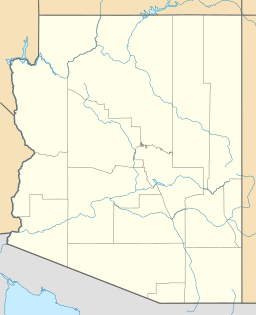Kartchner Caverns State Park
| Kartchner Caverns State Park | |
| Arizona State Park | |
|
The Big Room of Kartchner Caverns
|
|
| Country | United States |
|---|---|
| State | Arizona |
| County | Cochise |
| Location | Benson |
| - elevation | 4,734 ft (1,443 m) |
| - coordinates | 31°50′15″N 110°20′50″W / 31.83750°N 110.34722°WCoordinates: 31°50′15″N 110°20′50″W / 31.83750°N 110.34722°W |
| Biome | Chihuahuan Desert and Madrean Sky Islands |
| Founded | 1988 |
| Management | Arizona State Parks |
Kartchner Caverns State Park is a state park of Arizona, United States, featuring a show cave with 2.4 miles (3.9 km) of passages. The park is located 9 miles (14 km) south of the town of Benson and west of the north-flowing San Pedro River. Long hidden from view, the caverns were discovered in 1974 by local cavers, assisted by a state biologist who helped in its preservation.
The park encompasses most of a down-dropped block of Palaeozoic rocks on the east flank of the Whetstone Mountains.
The caverns are carved out of limestone and filled with spectacular speleothems which have been growing for 50,000 years or longer, and are still growing. Careful and technical cave state park development and maintenance are designed to preserve the natural cave system.
The caverns were discovered in 1974, when cavers Gary Tenen and Randy Tufts found a narrow crack in the bottom of a sinkhole, and followed the source of warm, moist air toward what ended up being more than 2.5 miles (4.0 km) of pristine cave passages with the help of Erick Campbell - a local state biologist. Hoping to protect the cave from vandalism, they kept the location a secret for fourteen years, deciding that the best way to preserve the cavern — which was near a freeway — was to develop it as a tour cave. After gaining the cooperation of the Kartchner family and working with them for ten years, together they decided that the best way to achieve the goal of protection through development as a tour cave was to approach Arizona State Parks. In 1985, The Nature Conservancy acquired an option to purchase the land. The discovery of the cave was finally made public in 1988 when the landowners sold the area to the state for development as a park and show cavern. Prior to its grand opening in 1999, the state spent $28 million on a high-tech system of air-lock doors, misting machines and other equipment designed to preserve the cave.
The two major features of the caverns currently available to the public are the Throne Room and the Big Room. The Throne Room contains one of the world's longest (21 ft 2 in (6.45 m))soda straw stalactites and a 58-foot (18 m) high column called Kubla Khan, after the poem. The Big Room contains the world's most extensive formation of brushite moonmilk; it is closed during the summer for several months (April 15 to October 15) each year because it is a nursery roost for cave bats.
...
Wikipedia


